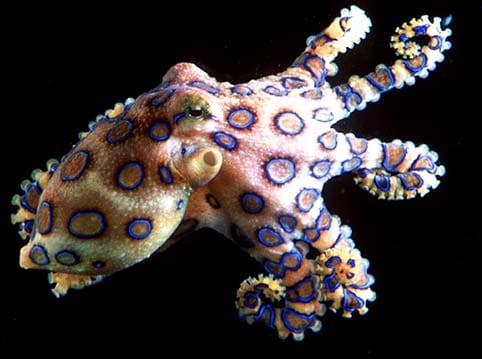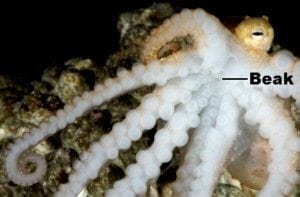It was the little octopus!
aka Toxicology Conundrum 011
A 21 year-old sailor placed a small blue and yellow octopus on his shoulder while wading back to shore after spear-fishing with a friend. As he reached the beach he threw the little octopus into the sea. The friend noticed a tiny trickle of blood from the sailor’s shoulder. The sailor was unaware of having been bitten, but soon complained of a dry mouth and difficulty breathing and was taken to hospital. On arrival at the hospital, the sailor was cyanosed and not breathing, but still had a pulse. The distraught friend said the sailor’s last words were, “It was the little octopus. It was the little octopus”. [Case based on Flecker 1955]
Questions
Q1. Are you kidding? A venomous octopus… Is it really venomous?
Answer and interpretation
No… and yes!
Squid, cuttlefish and octopus of all shapes and sizes have venom in their saliva, which they use to subdue their prey. Because they have retiring natures and are fast, they rarely bite humans. Only the Blue-Ringed Octopus (Hapalochlaena spp.) (or “BRO” for short – an acronym that comes easily to a Kiwi…) is a significant threat to humans.
The BRO (20cm at most from tentacle-tip to tentacle-tip) may look cute and cuddly by mollusk standards but it has a nasty surprise waiting for anyone that messes with it. The blue rings are best appreciated when they become iridescent… which occurs if the animal is irritated… which is when the BRO is likely to bite and inject its deadly venom!

The BRO has at least two deaths on its Australian “rap sheet”, the tragic death of a child in Singapore, plus a few other close calls…

Q2. Describe the venom of the BRO.
Answer and interpretation
BRO saliva contains “maculotoxin”. BRO tentacles are not venomous!
Maculotoxin was proven to be IDENTICAL to the tetrodotoxin of puffer fish (or fugu) by Sheumack and colleagues in 1978.
- It’s an evolutionary marvel that such diverse creatures use the exact same toxin. The reason for this is that the toxin is actually produced by a number of different species of bacteria, some of which live in the salivary glands and gut of the BRO.
- Maculotoxin blocks voltage-gated sodium channels in neurons and skeletal muscle (but not cardiac muscle), resulting in sensory and motor blockade.
- The main difference between BRO envenoming and pufferfish poisoning is its faster onset and the relative absence of gastrointestinal symptoms. This is largely because the venom is administered parenterally via a bite from the BRO’s parrot-like beak, rather than ingestion and slow absorption from the gastrointestinal tract.
Although maculotoxin is the main toxin in BRO saliva, other minor components facilitate envenoming.
- These components include biogenic amines, enzymes (like hyaluronidase) and “hapalotoxin”.
Q3. What is the distribution of the BRO.
Answer and interpretation
There are at least 6 species of Hapalochlaena in Australia, and no part of the Australian coastline is free of them. BRO are also found across South-east Asia from the Indian Ocean to Japan and the islands of the Pacific. It lives in shallow reefs and rock pools.
- The main species are H. lunulata in Northern Australia and the southern species, H. maculosa and H. fasciata.
Bites generally only occur if the octopus is removed from the sea and put in contact with skin.
- However, envenoming has resulted from accidentally squashing a BRO while walking through rock pools.
- One celebrated case of envenoming involved a BRO that got upset with being placed in the cramped confines between a woman’s breasts and her bikini top…
Q4. What are the clinical features of BRO envenoming.
Answer and interpretation
The clinical features include:
- An initial bite that may be completely painless. There may be no local signs, or only a small spot of blood.
- Systemic envenoming involves rapidly progressive symmetrical descending flaccid paralysis:
- Early signs include perioral paraesthesiae and numbness, ptosis, blurred vision, diplopia, and difficulty swallowing.
- This may progress to generalised flaccid paralysis, aphonia, fixed/ dilated pupils, and respiratory failure. In some cases cerebellar signs may be present.
- The patient remains conscious until hypoxia supervenes and cardiac arrest occurs.
- Symptoms progress rapidly in severe envenoming, over a period of minutes.
Q5. Describe how you would manage this patient.
Answer and interpretation
Prehospital care
- Apply a pressure-immobilisation bandage (PIB)
- Transport to a medical facility that can provide definitive airway support
Resuscitation, supportive care and monitoring –
- BRO envenoming is potentially life-threatening due to:
- Descending flaccid paralysis with respiratory failure
- Hypotension
- Cardiac arrest
- Rapid sequence intubation and ventilation is life-saving in the presence of respiratory failure.
- Reassure the patient and remember that he may be fully conscious despite being unable to respond – even if pupils are fixed and dilated.
Investigations –
- Spirometry or peak flow measurements may be useful for assessing respiratory function.
- Further investigations according to progress, procedures, and complications.
Decontamination, Enhanced elimination, Antidote – nil
Disposition –
- This patient has severe envenoming and needs ICU level care until complete resolution of his paralysis.
Q6. What is the prognosis of BRO envenoming.
Answer and interpretation
Not all BRO bites result in envenoming, and not all envenomings are severe.
- Patients with no clinical features of paralysis 6 hours after a BRO bite may be discharged, although discharge should not take place at night.
- With appropriate ventilatory support and supportive care the prognosis is excellent even for severe envenomings. Paralysis generally resolves spontaneously within 24 hours.
In the case described, because the patient was cyanotic on arrival at hospital, hypoxic organ injury is likely to have already occurred. The degree of hypoxic injury will ultimately determine the patient’s outcome.
- The 21 year-old sailor described by Flecker and Cotton in 1955 died 15 minutes after arrival at hospital despite assisted ventilation and repeated doses of adrenaline, most likely due to irreversible hypoxic myocardial injury. Death occurred less than 2 hours after the initial bite.
References
- Flecker H, Cotton BC. Fatal bite from an octopus. Med J Aust. 1955 Aug 27;42(9):329-31.
- Cavazzoni E, Lister B, Sargent P, Schibler A. Blue-ringed octopus (Hapalochlaena sp.) envenomation of a 4-year-old boy: a case report. Clin Toxicol (Phila). 2008 Sep;46(8):760-1. [PMID 19238736]
- Sheumack DD, Howden ME, Spence I, Quinn RJ. Maculotoxin: a neurotoxin from the venom glands of the octopus Hapalochlaena maculosa identified as tetrodotoxin. Science. 1978 Jan 13;199(4325):188-9. [PMID 619451]
- .. and check out this amazing footage of cephalopods from TED!

CLINICAL CASES
Toxicology Conundrum
Chris is an Intensivist and ECMO specialist at The Alfred ICU, where he is Deputy Director (Education). He is a Clinical Adjunct Associate Professor at Monash University, the Lead for the Clinician Educator Incubator programme, and a CICM First Part Examiner.
He is an internationally recognised Clinician Educator with a passion for helping clinicians learn and for improving the clinical performance of individuals and collectives. He was one of the founders of the FOAM movement (Free Open-Access Medical education) has been recognised for his contributions to education with awards from ANZICS, ANZAHPE, and ACEM.
His one great achievement is being the father of three amazing children.
On Bluesky, he is @precordialthump.bsky.social and on the site that Elon has screwed up, he is @precordialthump.
| INTENSIVE | RAGE | Resuscitology | SMACC
